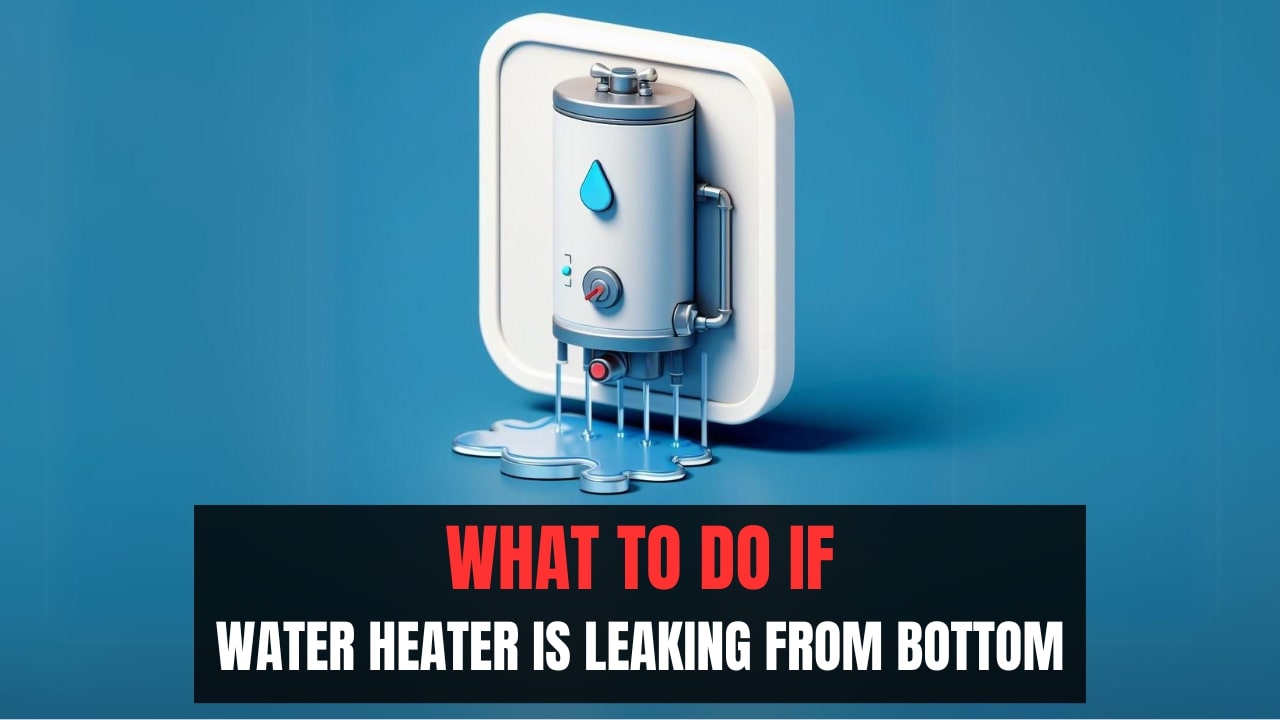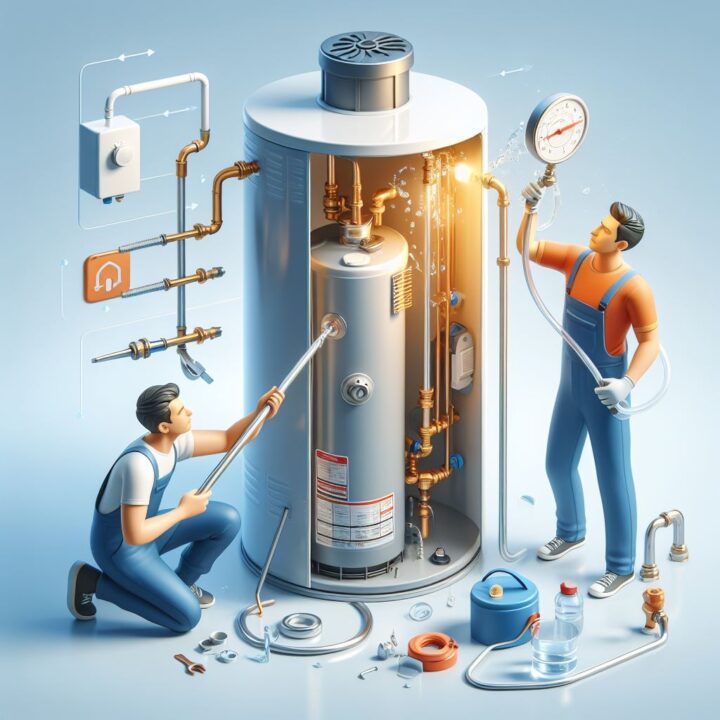
Water heaters are an essential appliance in our homes, providing us with hot water for various purposes like bathing, cooking, and cleaning. However, if your water heater is leaking from the bottom, it can be a cause for concern. This type of water heater leakage not only wastes water but also leads to potentially expensive repairs or replacements. In this article, What to Do If Water Heater is Leaking from Bottom, we will discuss what you should do if you encounter this issue.
What to Do If Water Heater is Leaking from Bottom
Before we dive into the solutions, it’s essential to understand why your water heater might be leaking from the bottom. The most common reasons for this type of leakage are a faulty temperature and pressure relief valve, loose drain valve, or corrosion inside the tank.
If you notice water pooling around the base of your water heater or small drips coming from the bottom, don’t panic.

Here are the steps you can take to address this issue:
Identifying the Source of the Leak
Before taking any action, it is crucial to identify where exactly the leak is coming from. Start by looking at the bottom of your water heater and determining if the water is coming from a specific spot, such as the drain valve or temperature and pressure relief valve. If you cannot pinpoint the source of the leak, try placing a paper towel around different areas of the tank to see where it gets wet.
The Drain Valve
The drain valve is located at the bottom of your water heater and is used to drain the tank for maintenance or repairs. If the leak is coming from this valve, it could be due to a loose or faulty valve. Try tightening the valve with a wrench, but be careful not to overtighten, as that can cause damage. If the leak continues, it might be necessary to replace the valve entirely.
The Temperature and Pressure Relief Valve
The temperature and pressure relief valve, also known as the T&P valve, is a safety feature that releases hot water and steam from the tank if the pressure or temperature inside becomes too high. If this valve is leaking, it could be an indication of high pressure or temperature in your water heater. In this case, it is best to call a professional plumber to inspect and fix the issue.
Turning Off the Water Supply
If the leak is coming from a different part of your water heater, you will need to turn off the water supply to prevent any further damage. Locate the cold water shut-off valve, usually located above or near your water heater, and turn it off by twisting it clockwise.
Draining the Tank
If you notice that your water heater is leaking from bottom, it’s important to take immediate action. Here’s what to do:

Once you have turned off the water supply, the first step is to drain the tank. Connect a garden hose to the drain valve located at the bottom of your water heater. You can either run the hose outside or place it into a large bucket. This will ensure that the leaking water is properly contained.
To assist with draining, open the pressure relief valve on the top of the tank. This will allow air to enter, facilitating the draining process.
Remember, addressing a leaking water heater promptly can help prevent further damage and potential safety hazards.
Repair or Replacement
After draining the tank, you can inspect the source of the leak more closely and decide if it is something you can repair yourself or if you need professional help. For minor leaks like a faulty valve or loose fitting, you may be able to fix it yourself with some basic tools.
However, if the tank itself is leaking, it will most likely need to be replaced altogether. In this case, it is best to consult a professional plumber for proper installation and to ensure the safety of your home.
Calling a Professional Plumber
After draining the tank, you can assess the damage and determine if it can be repaired or needs to be replaced. In either case, it is best to call a professional plumber who has the necessary expertise and equipment to handle water heater issues safely and efficiently.
Preventing Future Leaks
To prevent future leaks from occurring, it is essential to conduct regular maintenance on your water heater. This includes checking for any signs of corrosion, replacing old or faulty parts, and flushing the tank to remove sediment buildup. It is also recommended to replace your water heater every 8–12 years.

If you notice a leak from your water heater’s bottom, it can be a cause for concern. However, there’s no need to panic. Instead, follow the steps outlined in this article on What to Do If Water Heater is Leaking from Bottom. By identifying the source of the leak, turning off the water supply, draining the tank, and calling a professional plumber, you can effectively address the issue and prevent further damage.
It’s also important to conduct regular maintenance on your water heater to avoid future leaks and ensure its longevity. With proper care and attention, your water heater will continue to provide you with hot water for years to come. Remember, a little prevention goes a long way toward avoiding major problems. Stay informed, stay safe, and safeguard your water heater!
Additional Tips
- Regularly check for any signs of leakage or damage to your water heater.
- Familiarize yourself with the location of all the valves and safety features on your water heater.
- Consider getting a professional inspection of your water heater every few years to ensure it is working properly.
- If you live in an area with hard water, consider installing a water softener to prevent sediment buildup in your water heater. So, by following these tips, you can prevent any major issues with your water heater and ensure it continues to function efficiently for years to come. Stay informed and stay safe!
Conclusion:
In this article, we’ve discussed what to do if water heater is leaking from the bottom. By identifying the source of the leak, turning off the water supply, draining the tank, and calling a professional plumber, you can effectively address the issue and prevent further damage. Regular maintenance is crucial to preventing future leaks and ensuring the longevity of your water heater. Remember to stay informed, take prompt action, and seek professional help when needed. With proper care, your water heater can provide you with hot water for years to come.
FAQs:
Q: What are the signs that a water heater is leaking from the bottom?
A: Some signs to look out for include puddles of water around the bottom of the tank, a decrease in hot water supply, and an increase in your water bill. You may also hear hissing or rumbling noises coming from the tank.
Q: Can I fix a leaking water heater myself?
A: The resolution hinges on the origin of the leakage. If it is a minor issue, such as a faulty valve or loose fitting, you may be able to fix it yourself with basic tools. However, if the tank itself is leaking, it is best to consult a professional plumber for proper repair or replacement. So, always assess the situation carefully before attempting any repairs on your own.
Q: How often should I replace my water heater?
A: It is recommended to replace your water heater every 8–12 years. However, regular maintenance and routine inspections can help extend the lifespan of your water heater. You may also need to replace it sooner if you notice any signs of damage or malfunctioning. So, make sure to keep track of the age of your water heater and schedule regular maintenance to ensure its longevity.
Q: What are the potential causes of a water heater leaking from the bottom?
A: Some possible causes include a faulty temperature and pressure relief valve, loose fittings or connections, corrosion of the tank, or sediment buildup. Before embarking on any repairs, it is crucial to first pinpoint the origin of the leak. So, if you are unsure about the cause of the leak, it is best to seek professional help.
Q: What should I do if I notice my water heater is leaking from the bottom?
A: First, turn off the water supply to your water heater, and then drain the tank by attaching a hose to the drainage valve at the bottom of the tank. Once drained, assess the damage and decide if it can be repaired or needs to be replaced. It is best to consult a professional plumber for proper repair or replacement.
Home Maintenance Related Posts:
1. What To Do If Water Pump Keeps Running
2. What To Do If Pool is Overflowing From Rain
3. What to Do If Roof Is Leaking
4. What to Do If Accidentally Overfill Gas Tank



I enjoyed reading your piece and it provided me with a lot of value.
Thanks for posting. I really enjoyed reading it, especially because it addressed my problem. It helped me a lot and I hope it will help others too.
The next time I learn a weblog, I hope that it doesnt disappoint me as much as this one. I mean, I know it was my choice to read, but I really thought youd have one thing interesting to say. All I hear is a bunch of whining about one thing that you can fix should you werent too busy searching for attention.